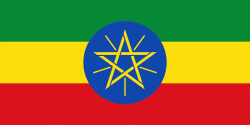Harar Meda Airport (Harar Meda Airport)
Harar Meda Airport (Ha'rar Me'da: ሐረር ሜዳ) is an airport in Bishoftu, Oromia, Ethiopia. It is the main base for the Ethiopian Air Force.
In 1946, the beginnings of what became the Ethiopian Air Force were moved from Lideta Airfield in Addis Ababa to Bishoftu. The former facility was instead utilized by Ethiopian Airlines. The initial group of 19 Swedes under Count Carl Gustaf von Rosen, who were to train the pilots and support personal, arrived there after leaving Sweden between 9 January and 16 July 1946. Both Ethiopian cadets and the Swedish instructors took part in constructing the first buildings on the base. Six Saab 91 Safir training airplanes were bought in Sweden and flown to the new airbase on 24 December 1946. On 10 November 1947, a fleet of 16 Saab-built B-17s was landed at Bishoftu by Swedish pilots.
The airport has been used for civilian operations in the past, mainly when Bole Airport was unserviceable due to construction works. In 2005, the airport served 101,839 passengers.
2012 satellite imagery shows a number of helicopters, fighters and transport aircraft are based there.
In 1946, the beginnings of what became the Ethiopian Air Force were moved from Lideta Airfield in Addis Ababa to Bishoftu. The former facility was instead utilized by Ethiopian Airlines. The initial group of 19 Swedes under Count Carl Gustaf von Rosen, who were to train the pilots and support personal, arrived there after leaving Sweden between 9 January and 16 July 1946. Both Ethiopian cadets and the Swedish instructors took part in constructing the first buildings on the base. Six Saab 91 Safir training airplanes were bought in Sweden and flown to the new airbase on 24 December 1946. On 10 November 1947, a fleet of 16 Saab-built B-17s was landed at Bishoftu by Swedish pilots.
The airport has been used for civilian operations in the past, mainly when Bole Airport was unserviceable due to construction works. In 2005, the airport served 101,839 passengers.
2012 satellite imagery shows a number of helicopters, fighters and transport aircraft are based there.
Map - Harar Meda Airport (Harar Meda Airport)
Map
Country - Ethiopia
 |
 |
| Flag of Ethiopia | |
Anatomically modern humans emerged from modern-day Ethiopia and set out to the Near East and elsewhere in the Middle Paleolithic period. Southwestern Ethiopia has been proposed as a possible homeland of the Afroasiatic language family. In 980 BCE, the Kingdom of D'mt extended its realm over Eritrea and the northern region of Ethiopia, while the Kingdom of Aksum maintained a unified civilization in the region for 900 years. Christianity was embraced by the kingdom in 330, and Islam arrived by the first Hijra in 615. After the collapse of Aksum in 960, a variety of kingdoms, largely tribal confederations, existed in the land of Ethiopia. The Zagwe dynasty ruled the north-central parts until being overthrown by Yekuno Amlak in 1270, inaugurating the Ethiopian Empire and the Solomonic dynasty, claimed descent from the biblical Solomon and Queen of Sheba under their son Menelik I. By the 14th century, the empire grew in prestige through territorial expansion and fighting against adjacent territories; most notably, the Ethiopian–Adal War (1529–1543) contributed to fragmentation of the empire, which ultimately fell under a decentralization known as Zemene Mesafint in the mid-18th century. Emperor Tewodros II ended Zemene Mesafint at the beginning of his reign in 1855, marking the reunification and modernization of Ethiopia.
Currency / Language
| ISO | Currency | Symbol | Significant figures |
|---|---|---|---|
| ETB | Ethiopian birr | Br | 2 |
| ISO | Language |
|---|---|
| AM | Amharic language |
| EN | English language |
| OM | Oromo language |
| SO | Somali language |
| TI | Tigrinya language |















